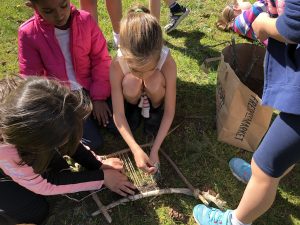The Walking Curriculum

To view the photo-rich magazine version, click here.
Originally appears in the Spring 2020 issue.
By Gillian Judson
[Originally published in the BC Art Teachers’ Association Journal, Vol 61(2), 2020]
We learn a place and how to visualize spatial relationships, as children, on foot and with imagination. Place and the scale of place must be measured against our bodies and their capabilities.1
Engaging with nature ignites the imagination and fuels human curiosity. There is an openness and a complexity in nature that engages our sense of wonder. There is a sensuousness that engages the somatic imagination — the body’s main senses, yes, but also our sense of the musical, our awareness of incongruity, our identification of patterns, rhythms. As many artists know deeply, nature inspires.
Add the revolutionary act of walking to the mix, and one fuels the imagination further, opening up possibilities for wider implications for learning and being. Dan Rubinstein, author of Born To Walk: The Transformative Power Of A Pedestrian Act, describes walking as “a tonic for body, mind, and soul.”2 Walking, he says, not only benefits our bodies but also our communities:
[Walking] can restore health and inspire hope in places where there is not much of either. Because it can help re-plant the seeds of independence and interdependence, two things we cannot bloom without. Michael Pollan distilled his receipt for a healthy diet into seven simple words. Eat food. Not too much. Mostly plants. My manifesto fits into three. Walk more. Anywhere.2
Indeed, walking has been called the “magic pill” for wellness as it can positively impact so many aspects of our physical and mental health. Walking out in nature — engaging in nature more routinely is, I believe, also required to save the planet. The idea within this seemingly naive claim is simple: we need to have opportunities to connect and to form relationships with the natural world if we are going to fight to save it. Research shows that meaningful experiences in nature as children can impact the development of a conservation ethic.3, 4, 5, 6, 7
This content is restricted to subscribers only.
If you are not yet a subscriber, please consider taking out a subscription here.
If you are an existing subscriber, kindly log in or contact us at info@greenteacher.com for more information.










